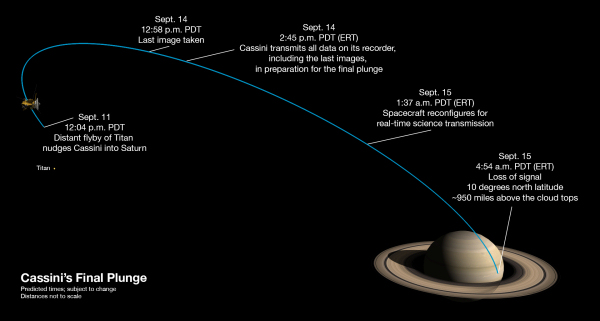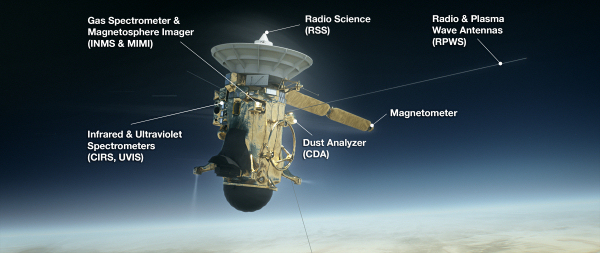How to follow Cassini's end of mission
12 September 2017
The international Cassini mission reaches its dramatic finale this Friday by plunging into Saturn's atmosphere, concluding 13 years of exploration around the ringed planet. |
| Cassini's last week. Credit: NASA/JPL-Caltech |
Here's when to follow events broadcast by NASA via https://www.nasa.gov/nasalive this week (dates and times below are given in UTC/CEST; all times subject to change).
You can also watch the live stream on this page:
(Note that other broadcasts will play here outside of the below times)
| 13 September | |
| 17:00 UTC / 19:00 CEST: |
News conference with a detailed preview of final mission activities |
| 15 September |
|
| ~03:00 UTC / ~05:00 CEST: |
Final images expected to begin appearing online in Cassini raw image gallery |
13:00-14:30 CEST: |
Live commentary, covering end of mission (loss of signal expected on Earth ~11:54 UTC/13:54 CEST) |
| 13:30 UTC / 15:30 CEST: |
Post-mission news conference |
A detailed end of mission timeline is provided here (times in EDT are UTC -4h).
Mission updates are provided on Twitter from NASA's @CassiniSaturn account, and shared via @esascience. On 15 September @esaoperations will also share live updates from ESA's mission control in Darmstadt where teams will follow Cassini's final plunge using the Agency's deep-space ground station in Australia.
 |
| Science during Cassini's descent. Credit: NASA/JPL-Caltech |
Good to know:
- It takes about 83 minutes for radio signals to travel across the 1.4 billion km between Earth and Saturn.
- No images will be taken during the final plunge into Saturn, as the data transmission rate required to send images is too high and would prevent other high-value science data from being returned.
- The final images will be taken on 14 September and are planned to include images of Titan, Enceladus, moonlet 'Peggy', a propeller feature in the rings and a colour montage of Saturn and its rings, including the aurora at the north pole (examples of previously released images of these targets are shown here).
- Eight instruments (CDA, CIRS, INMS, MAG, MIMI, RPWS, RSS, UVIS) will collect data during the final plunge, transmitting it back to Earth in near-real time.
- The mission is ending because, after two decades in space, its fuel is running out. To ensure a safe disposal of the spacecraft, and to avoid an unplanned impact onto pristine icy satellites such as ocean-bearing moon Enceladus, Cassini is being directed into the gas planet itself, where it will burn up.
- Since April, Cassini has been making weekly dives through the 2000 km gap between Saturn and its rings. This 'Grand Finale' maximises the scientific return of the mission, giving close dives past the inner and outer edges of the rings and the planet's small inner moons, as well as close encounters with the upper reaches of Saturn's atmosphere.
- The 22 Grand Finale orbits were supported by ESA ground stations, which received signals from Cassini to gather crucial radio science and gravitational science data.
- A final distant flyby with Titan on 11 September gave the gravitational assist needed to put the spacecraft on an impact course with Saturn.
More information:
NASA's Cassini Grand finale toolkit
NASA's Cassini End-of-Mission press kit
More about Europe's contributions to Cassini


